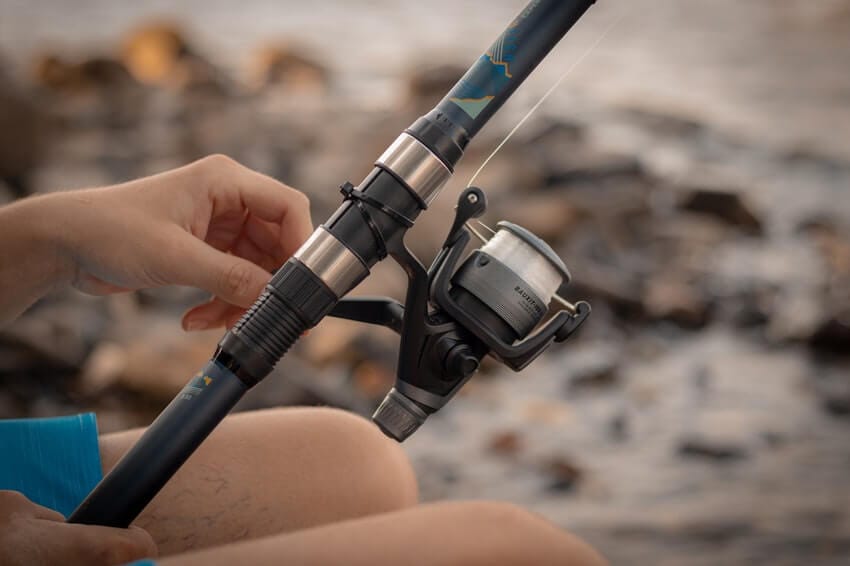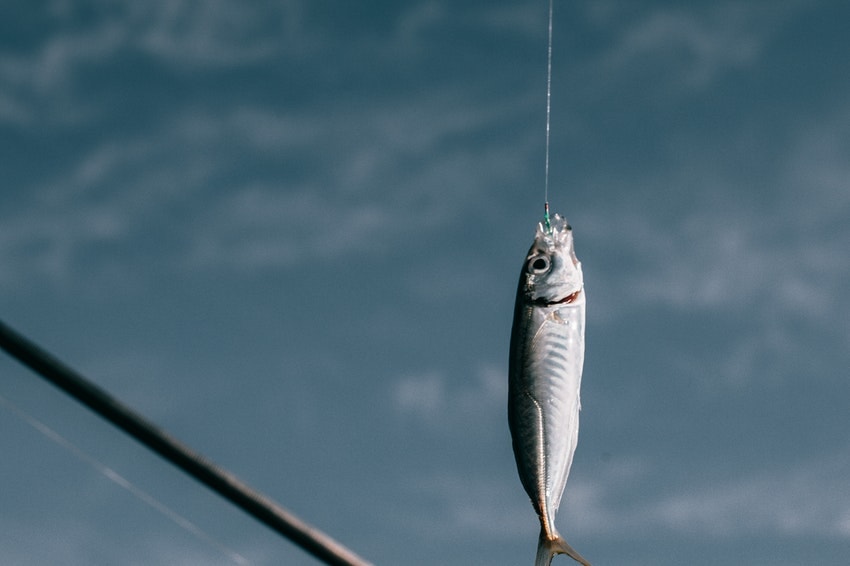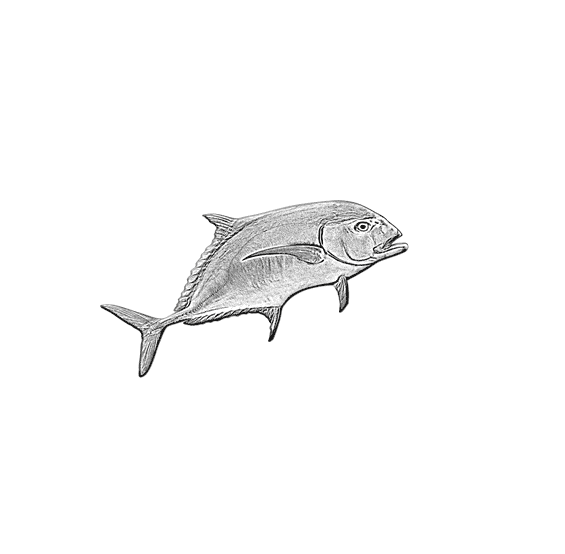Picking a fishing line can be a very confusing trip to the sporting goods store, and even more painful if you are shopping online. If you do not get the right fishing line for your rod, and what you are wanting to fish for there could be some serious issues.
If you don’t get a strong enough line, your line will break, but if you get to heavy of a line you will not feel the fish bite. With mono, fluoro, and braided lines now being so popular, it’s hard to even know where to begin.
Fishing line strength is measured in how many pounds of force it takes to break the line, but that doesn’t mean that 6lb test cannot catch a 10lb fish. Drag and how you play the fish directly relate to how big of a fish you can catch. It all comes down to technique and what you do when the fish decides he has one last bit of energy left to get away.
There is a lot of physics that go into the strength of fishing line, and its ability to keep from snapping. See below fishing line strength chart.
What Does Pound (LB) Test Mean When Buying Fishing Line?
When we talk about fishing line strength, we always talk about “pound test” or “lb test” because fishing line strength is rated in pounds. This is how much pressure needs to be applied to your fishing line to break it.
So if you have four pound test line on your reel, it will take a fish four pounds of pressure to snap, or break it off. The higher the test, the more pressure a fish will need in order to break your line.
Keep in mind that fish will surge and try and bolt away from you when you are reeling them in. They will get tired and give up for a few seconds and then a surge of energy will come over them and they will use all their strength to get away. When this happens, you have to be very careful of snapping your line, and that is where drag comes in.
What Is Drag On a Fishing Reel?
Drag on a fishing reel is a setting that most newer, and more expensive fishing reels come with that will automatically let line out when pressure or force is applied to it.

Usually this will be on the top of your reel, and you can turn it clockwise for tight, and counter clockwise for loosen. When you loosen it, less pressure needs to be applied to for your reel to let line out.
This is going to help you a lot when you have a bigger fish out because when they surge, instead of snapping your line, it will let a little bit out and when the surge is over, you can continue to reel normal again.
If you happen to catch a fish that weighs more than your “lb test” line can handle, you have a better chance of landing it, and not breaking your whole rig off.
What Are the Different Types of Fishing Line
There are several popular types of fishing line available for purchase. Below I cover three of the top fishing lines and some of details that are important to consider for each.
Monofilament Line
Monofilament, or “mono” line, is a single strand of material that is normally nylon, instead of multiple strands. This is the mostcommon type of line.
Monofilament is less expensive than the braid and fluorocarbon options. Some of the other benefits include:
- More stretch
- Better at holding knots
- Lower sink rate
- Comes in many different colors
My top pick for a monofilament line is the Trilene XL option from Berkley.
Fluorocarbon Line
Flourocarbon, or “fluoro” line, is made up of compounds, including organics comprised of fluorine, chlorine and carbon, along withsynthetics made from hydrocarbons.
It is a single strand like mono, but is heavier and more dense, so it will sink faster, and is more visible in the water to fish. Some of the other benefits include:
- Nearly invisible
- Stronger than monofilament
- Non-absorbent to water
- Long-lasting
Fluorocarbon may be a little overkill for most occasional fishermen, but it can make all the difference in pulling in that once-in-a-lifetime fish. My favorite fluorocarbon line as of today is the Berkley Trilene Fluorocarbon product line.
Braided Line
Braided line is a series of lines braided together to form a single line. This makes the fishing line much stronger and harder to andyou will see that lb test lines are geared for heavier fish, but are lighter line.
So you might have a 15lb test braid that is the same weight and diameter of 6lb mono line. Some of the other benefits include:
- Better sensitivity to feel fish bite
- Thinner diameter allows for more line on your reel
- Better casting distance
- Lasts long
Like fluoro line, this option is stronger compared to the normal mono line choices. Braided line may be worth looking into depending on what you are fishing for. My favorite braided line as of today is the Power Pro Spectra Fiber product line.
What Pound Test You Should Use for Common Fish
I have included a nice chart below that will cover most of your typical needs for fishing and what strength test to use. The fish below are the most common species people in the United States fish for.
| Line Test (In lb’s) | Fish Type |
| 2-4 lb | Panfish, Trout, Bluegill, Small Mouth Bass |
| 6-12 lb | Large Mouth Bass, Catfish, Walleye, Smaller Salmon |
| 14-20 lb | Catfish, Stripers, Pike/Musky, Carp |
| 8-14 lb | Sea Trout, Flounder, Sea Bass |
| 16-25 lb | Redfish, Stripers, Salmon |
| 30lb and above | Tuna, Marlin, Shark, and other large sea fish. |
Is One Type of Fishing Line Better Than the Others?
The short answer is no, it really depends on what the angler likes to use and what they fell works best for them. I use braid on all my bass rods, with a 20 to 30 yard mono leader line, so the fish cannot see it.
Braided line is extremely strong for the diameter, but it is not clear like fluoro and mono, so they say the fish can see it.
Try out different setups to see what works best for you in the locations that you most commonly fish. If you are fishing in a new area for a new species, stop by the local bait and tackle shop to trim your learning curve on the best tackle to use.
Using Physics When Reeling in a Fish to Avoid Line Breaks
While science and physics play a major role in how strong a fishing line might be, there is also a technique that many anglers learn over time of how to “play” the fish and when to let drag out that helps from snapping your line.
You have to know when to loosen the drag, and how much line to let out at one time. If you loosen the drag too much and let too much line out, you will never land the fish, and it could possibly shake the hook and swim away.

While picking the right pound test line is always going to be the best way to ensure the line does not snap, play with your drag, and when you do hook a fish, learn to feel when you think the fish is going to surge. Practice will always make perfect in this area of fishing.
Related Questions Specific to Trout and Bass
Since bass and trout are arguably the most common species to fish for, I wanted to provide basic answers regarding what line strength to use for these fish.
What Is The Best Pound Test for Bass?
When you are hunting bigger fish like bass, you will want to go with around 8 to 12 pound test. I normally use a 12 pound braided line with a 20 yard leader line attached to it.
This gives me some very good strength with a smaller diameter line, but the mono leader gives me that extra yardage so the bass do not see it. It is said that fish can see the line in the water, so that extra leader helps trick them into biting my bait.
What Is The Best Pound Test for Trout?
For your normal trout fishing, you are going to want to use around the 4lb test marker for a typical reel setup. Sometimes I will use an ultra-light rod and reel with a 2lb test on it so I can cast further, but for the most part, 4lb will do just fine.
If you know there are some big trout where you will be fishing, a 6lb test is where you might want to be so you don’t have the fish continuously breaking your line.

